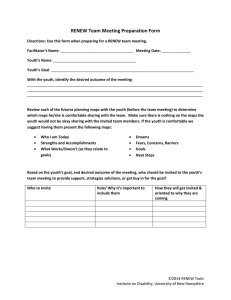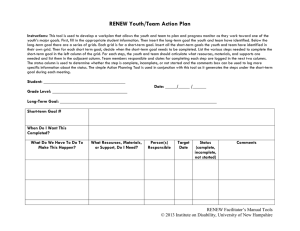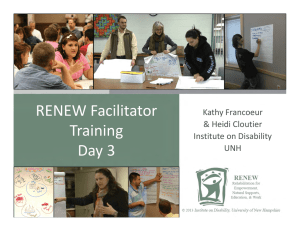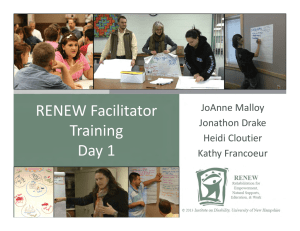RENEW Youth Needs and Strengths Checklist
advertisement
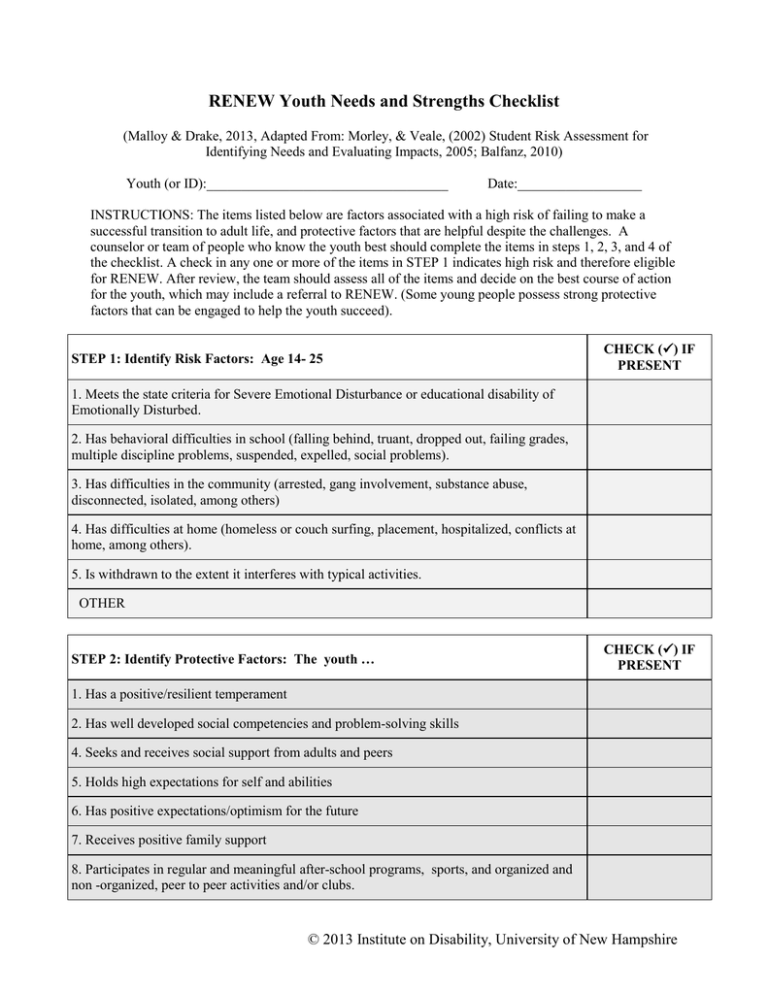
RENEW Youth Needs and Strengths Checklist (Malloy & Drake, 2013, Adapted From: Morley, & Veale, (2002) Student Risk Assessment for Identifying Needs and Evaluating Impacts, 2005; Balfanz, 2010) Youth (or ID):___________________________________ Date:__________________ INSTRUCTIONS: The items listed below are factors associated with a high risk of failing to make a successful transition to adult life, and protective factors that are helpful despite the challenges. A counselor or team of people who know the youth best should complete the items in steps 1, 2, 3, and 4 of the checklist. A check in any one or more of the items in STEP 1 indicates high risk and therefore eligible for RENEW. After review, the team should assess all of the items and decide on the best course of action for the youth, which may include a referral to RENEW. (Some young people possess strong protective factors that can be engaged to help the youth succeed). STEP 1: Identify Risk Factors: Age 14- 25 CHECK () IF PRESENT 1. Meets the state criteria for Severe Emotional Disturbance or educational disability of Emotionally Disturbed. 2. Has behavioral difficulties in school (falling behind, truant, dropped out, failing grades, multiple discipline problems, suspended, expelled, social problems). 3. Has difficulties in the community (arrested, gang involvement, substance abuse, disconnected, isolated, among others) 4. Has difficulties at home (homeless or couch surfing, placement, hospitalized, conflicts at home, among others). 5. Is withdrawn to the extent it interferes with typical activities. OTHER STEP 2: Identify Protective Factors: The youth … CHECK () IF PRESENT 1. Has a positive/resilient temperament 2. Has well developed social competencies and problem-solving skills 4. Seeks and receives social support from adults and peers 5. Holds high expectations for self and abilities 6. Has positive expectations/optimism for the future 7. Receives positive family support 8. Participates in regular and meaningful after-school programs, sports, and organized and non -organized, peer to peer activities and/or clubs. © 2013 Institute on Disability, University of New Hampshire CHECK () IF PRESENT STEP 2: Identify Protective Factors: The youth … 9. Lives in a safe and cohesive neighborhood where there are opportunities for participation is positive activities. STEP 3: History of Interventions: Intervention or program: Number of weeks: Youth Response: Data Used: STEP 4: Discuss or Review the following Questions: 1. Is there additional information needed? What questions do we have about this young person? 2. Has a recent (within the past year) assessment such as a function-based behavioral assessment (FBA) been conducted, or does an FBA to be completed in the next few weeks? What does the assessment tell us? 3. Does the young person have protective factors and resources that mitigate the need for services and supports? 4. Why did some of the other programs or interventions fail (if applicable)? 5. What is the potential for imminent crises to arise? How can we mitigate potential crises? 6. Does this young person seem to need person-centered planning? Does he/she need more positive attachments and engagements with adults and peers in school, home and community? Does he/she need help with connections and individualized supports? 7. Who do we need to talk to? © 2013 Institute on Disability, University of New Hampshire STEP 5: ACTION PLANNING, within the next 2-3 weeks: ACTION NEEDED PERSON RESPONSIBLE © 2013 Institute on Disability, University of New Hampshire

